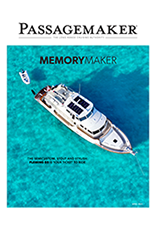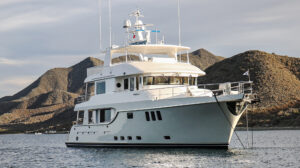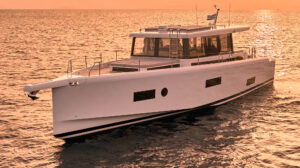
Included within the broadest community of cruising aficionados are discernible migratory patterns as owners’ needs and preferences evolve and lifestyle patterns change over time. One subset personifies upward mobility, its members trading into a succession of larger vessels in order to accommodate growing families and lengthier itineraries. Another group, many whose offspring have matured and perhaps relocated to distant venues, shows a reversal of that trend, opting to move down in size, if not in passagemaking ambitions. Still others, in large part experienced long-range cruising enthusiasts, seek to simplify the on-water experience with a transition from sail to power.
These trajectories seem, at one point or another, to converge on a category of compact power cruisers in the 35- to 45-foot range, at once small enough to be easily operated and maintained by an owner couple, and of a sufficient size, range and fit-out to allow voyages measured in weeks if not months. Factor in the persistently high cost of fuel, and it’s no mystery why the single-screw displacement or semi-displacement configuration has become a favored component of this genre.
By design, the above factors and categories precisely define the market toward which Seattle-based Helmsman Trawlers has focused its efforts. Helmsman Trawlers builds its vessels in Fuzhou, China, at a yard that has been engaged in the manufacture of mid-sized trawlers since 2006, and currently is represented in Florida by Massey Yacht Sales, and by Waterline Boats in the U.S. Pacific Northwest. Sales and distribution in other North American regions are managed directly by Helmsman Trawlers.
Scott and Lisa Helker, owners of Waterline Boats and principals in the Helmsman Trawlers organization, earlier had purchased for their personal use a 38-foot pilothouse trawler, the second vessel to emerge from the Helmsman yard, and through personal experience recognized their boat’s attributes as relevant and timely responses to the evolving preferences of their clientele.
DESIGN AND CONSTRUCTION
From the 38-foot pilothouse, the Helmsman range has grown to include a 43-foot raised-pilothouse, a 42-foot raised-sundeck cruiser, the 37 Downeast, executed in the Maine lobsterman style, and a 35-foot single-stateroom sedan, each one built on variations of an original full-and semi-displacement hull design by Canadian naval architect Leonard LaPierre. Most recently, the yard has added a two-stateroom variant of the sedan model, the first of which arrived this spring at the Waterline Boats’ docks on Lake Union in Seattle, just in time for a final fit-out and its North American debut at the Trawler Fest boat show in nearby Anacortes.
Concurrent with the introduction of the two-stateroom version, the Helmsman Trawlers’ yard modified the hull design that the two sedan models share, extending the bottom by approximately two feet beneath the transom platform, thus integrating the swim grid into the hull structure and providing space for two 70-gallon stainless steel freshwater tanks. That same extension allows for a lengthening of the keel and a commensurate increase in the size of the stainless steel rudder, modifications that Scott Helker says improve straight-line tracking compared to that of the earlier 35.
Otherwise, the hull offers straightforward underbody geometry, with a relatively steep forefoot tapering aft to virtually zero deadrise at the transom, and round bilges curving upward to moderate spray knockers just above the waterline. With its 13-foot 11-inch beam, according to Helker, the Helmsman 37 can accommodate walkaround decks on either side and still offer a good-sized saloon. “Access all around the main deckhouse is always an advantageous feature for line handling,” he says, “and we’ve found that many of our clients making the transition from sail to power will consider nothing but the full walkaround configuration.”
Like all Helmsman offerings, the new 37 features hull construction of solid FRP, its innermost layers laid up using isophthalic resin, and the outermost with a vinylester formulation as a guard, along with an epoxy barrier coat and antifouling paint, against osmotic blistering. A grid of foam-cored stringers and transverse box beams stiffens the hull, and house sides, deck and structural bulkheads are foam-cored fiberglass NidaCore honeycomb coring reinforces the flybridge deck.
While standard power is a single 230hp Cummins QSB common-rail diesel, Waterline Boats’ inaugural offering was equipped with the 380hp Cummins, sufficient power on test day to achieve a semi-displacement maximum speed of nearly 13 knots. That’s a worthwhile capability if you’re hustling to make port ahead of a squall or bucking a current in the narrowest reaches along British Columbia’s Inside Passage, but it also allows throttling back to displacement mode, and to speeds that can easily triple cruise range compared to the full-throttle burn rate.
ACCOMMODATIONS FOR FOUR
While many of those owner couples who rarely cruise with guests on board inevitably will find favor with the 37-foot single-stateroom sedan, the newest version of course adds the considerably broader appeal of the second private accommodation, located on the port side just aft of the forward master stateroom. This space features a double berth positioned athwartship and nested beneath the saloon observers’ lounge just above; an adjacent dressing area offers standing headroom, vanity, and a compact hanging locker. In the master cabin forward are an island double berth on centerline, bookshelves, and hanging lockers on either side, and an opening skylight hatch overhead. The two staterooms share a starboard-side head with a separate shower stall.
From the lower deck companionway, four steps lead up to a main deck saloon that is well illuminated by large windows. A lower helm station occupies the forward starboard corner of the saloon, and includes a double-wide seat, with flip-down bolster, facing engine controls, and navigation display panel. Whereas the original of this series had been fitted with a Simrad NSE12 multifunction display for radar, fathometer, autopilot, and AIS transceiver, the Seattle dealer like many others more typically specifies a navigation suite according to each client’s preferences. An aluminum weather door here slides easily on its stainless steel frame to provide access to the starboard side deck. Installed beneath the helm seat is the main electrical panel, perhaps not the most convenient location for quick access, but circuits are well marked and labeled.
Just aft, arrayed along the starboard side of the saloon, is a galley equipped with a propane range, stainless steel sink, drawer and cabinet storage, and a NovaKool under-the-counter fridge with separate freezer. Just overhead are three drop-down cabinets, two for storing dishes and other galley items and the other to support an optional 24-inch flat-screen television for viewing from the portside lounge/dining banquette, a fixture which also converts for use as a third berth. Just forward, opposite the lower helm is a raised L-shaped lounge that allows two or three guests to converse with the pilot while enjoying the view ahead.
A trio of Manship stainless steel opening portholes—one on either side of the saloon and one in the aft saloon bulkhead—impart a salty look while admitting additional ventilation and daylight. LED lighting fixtures illuminate all living spaces, and the engine room is fitted with fluorescent lamps. Depending on climate considerations the owner may specify a Webasto furnace or an optional heating and cooling system.
ON DECK
A second weather door leads through the aft bulkhead to a good-sized aft deck, then through a starboard-side transom door to the swim platform, with a hot-and-cold freshwater shower unit concealed in the cockpit coaming nearby. The aforementioned side decks extend forward under cover of flybridge deck overhangs to the foredeck, where, a Lewmar V4 electric windlass stands ready to deploy or retrieve a 45-pound stainless steel anchor. Exterior hardware appears more than equal to the demands of a 37-footer, and includes 1-1/4-inch railings secured to the deck through stainless steel backing plates. Deck hardware includes good-sized bollards, no fewer than six hawse rings, and a mooring bitt on the foredeck. For ease of dockside access, the boat as tested was equipped with optional port-and-starboard side boarding gates in addition to the standard transom door.
Access from the cockpit to the flybridge deck is by way of a stairway, its lower half integrated into a molded cabinet at the starboard side of the aft deck and its upper half FRP treads in a welded stainless steel framework. A smoked glass cover opens to allow passage to or from the bridge through a hatchway in the aft deck overhead, and closes on a weather-tight seal to keep the lower deck dry. As evidenced by observing runoff from the top deck following a recent shower, the Helmsman design team has taken care to direct rainwater, through a pattern of molded-in gutters and channels, overboard instead of onto lower exterior levels.
The upper helm station is located forward on the starboard side within a coaming that’s a couple of feet narrower than the deck’s outboard edges, leaving a ledge, enclosed by perimeter railings, that allows convenient storage of kayaks, crab pots, or other accoutrements. The bridge coaming also encloses a portside U-shaped lounge with a pedestal table that may be removed and replaced with filler cushions to form a large sunpad. A composite signal mast supports requisite antennas, and hinges down as necessary to reduce bridge clearance. The aftmost part of the bridge deck can accommodate lounge chairs, perhaps a smallish tender, and in the case of the test boat, an optional fiberglass cabinet for refreshment service.
A large hatch nicely fitted to the teak-and-holly saloon sole opens to reveal the boat’s mechanical spaces; a short ladder secured to the starboard side may be removed to permit access around the main engine. It’s a little snug making one’s way to the engine’s port side, but not unusually so for a vessel this size, and FRP diamond-plate decking all around provides good working surface. Dual Racor fuel filters and the fuel management panel are agreeably easy to reach on the engine room’s aft bulkhead, and a plexiglass panel in the deck plate just above the shaft log permits frequent visual inspection.
A separate, enclosed space just forward of the main on the starboard side houses a termination panel, which amounts to a convenient access point for primary 12-volt circuits, including lighting and outlets, in addition to spare circuits for adding accessories. As a separate space, this compartment also provides a good location for navigation electronics processors and the autopilot compass. The Helmsman yard goes to considerable length to simplify the installation of aftermarket equipment and upgrades, and in addition to the termination panel provides easy access, via removable panels, to wiring chases in overhead structural beams, and includes pre-installed wiring and plumbing for a generator.
CASTING OFF
Scott and Lisa Helker, an experienced cruising couple, made easy work of casting off lines on test day, and negotiating the tight confines of a busy Lake Union marina, thence into the Lake Washington Ship Canal and through the Montlake Cut en route to Lake Washington for a series of speed trials. The 37 handles easily at all throttle settings, and at semi-displacement speeds seems to like just a little help from the optional Bennett trim tabs to level the bow for an extra half-knot or so at the top end. Rudder response is quick and decisive at maneuvering speeds, and the single-screw hull, predictably enough, is happier backing to starboard, although the standard 7-inch side-power bow thruster goes a long way toward evening that score either way.
Moderately hard turns at cruising speeds produce virtually no heel, and the hull feels sure-footed carving to the left or the right. Notwithstanding the absence of hull coring to help deaden mechanical noise, interior sound and vibration levels seem reasonably attenuated throughout the rpm range, indicating comfortable cruising during long passages. Sightlines from either helm seat are uniformly good, with minimal interruption at the lower station from window frames or from the outboard legs supporting the top deck’s outboard edges. The upper helm’s off-center location favors easing up to a starboard-side tie, and allows adequate visibility on that side even over the narrow expanse of deck outside the bridge coaming. Docking portside-to may require the assistance of a spotter.
Returning to the dealership, Helker backed the Helmsman 37 into its assigned slip with no fuss and only an occasional nudge from the electric thruster. Here, the routine of securing lines, closing hatches and shutting down onboard systems provided a final opportunity to note a few more of the boat’s finer points. Among these are a yacht-caliber yoke securing the rudder post’s top bearing against torque loads from the hydraulic steering ram, the use of bronze seacocks on all underwater through-hull fittings, and the obligatory double stainless steel clamps on all hose connections.
“With this boat,” Scott Helker notes, “Helmsman Trawlers has created a comfortable seagoing environment—at less than $400,000 fully equipped—for couples who frequently include family and guests on extended cruises. The two-stateroom arrangement ensures privacy, and the salon and bridge-deck seating purposely designed for sociability.” Add to that the boat’s well-found list of standard equipment and the thoughtful, no-nonsense installation of operating systems, and the Helmsman 37 Two-Stateroom Sedan offers an intriguing choice for prospective owners whether they’re moving up or down in size.
SPECIFICATIONS
LOA 38’ 11”
LOD 36’ 9”
BEAM 13’ 11”
DRAFT 3’ 6” (half load)
DISPLACEMENT 28,000 lb. (half load)
BRIDGE CLEARANCE 18’ 10”/12’ 4” (mast up/down)
ENGINE 1 X 230hp Cummins QSB diesel (standard)
ENGINE 1 X 380hp Cummins QSB diesel (optional) (Other ratings up to 480hp available)
FUEL 360 U.S. gal
WATER 140 U.S. gal.
HOLDING TANK 30 U.S. gal.
WATERMAKER N/A
GENERATOR(S) N/A
MAXIMUM SPEED 12.7 knots (with optional 380hp)
CRUISE SPEED 7.5 knots (with optional 380hp)
RANGE AT CRUISE SPEED 1010nm at 7.5 knots (10% reserve)
DESIGNER Helmsman Trawlers/Leonard LaPierre
BUILDER Helmsman Trawlers
BASE PRICE $339,000
PRICE AS TESTED $390,793
For more information:
Helmsman Trawlers
2046 Westlake Ave. North, Suite 203, Seattle WA 98109
206.282.0110
www.helmsmantrawlers.com











